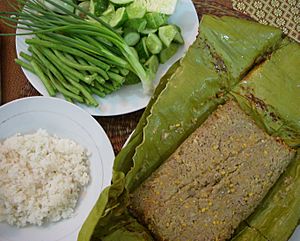Prahok facts for kids

Prahok wrapped in banana leaves and grilled and served with fresh green vegetables and steamed rice.
|
|||||||
| Place of origin | Cambodia | ||||||
|---|---|---|---|---|---|---|---|
| Region or state | Southeast Asia | ||||||
| Associated national cuisine | Cambodia | ||||||
| Main ingredients | fermented fish | ||||||
| 125 kcal (523 kJ) | |||||||
|
|||||||
| Similar dishes | Ngapi, Bagoong, Shrimp paste | ||||||
Prahok (/ˈprɑːhʊk/; Khmer: ប្រហុក, romanized: prâhŏk, IPA: [prɑːhok]) is a special kind of fish paste from Cambodia. It is made by salting and fermenting fish, usually a type of mudfish. People in Cambodia use prahok to add flavor to their food, like a seasoning or a condiment.
This unique paste was first created as a way to keep fish fresh for a long time. This was especially helpful during months when there wasn't a lot of fresh fish available. Because prahok is salty and has a very strong taste, it became a key ingredient in many Cambodian cuisine dishes. You'll find it in soups and sauces. There's even a Cambodian saying that means "No prahok, no salt," which shows how important it is to their cooking.
Prahok has a very strong and unique smell. Because of this, some people jokingly call it "Cambodian cheese." It is often eaten as a main dish with white rice and fresh vegetables. Some common vegetables served with it include yardlong beans, cucumbers, winged beans, and Thai eggplant.
Sometimes, charities give prahok to people who have been affected by floods or droughts. This helps them have food when other supplies are low. While prahok can be cooked or fried, it is usually not eaten raw. This is because raw prahok can spoil quickly and has a very strong smell that most people find unpleasant when uncooked.
Contents
How Prahok is Made
Prahok can be made using different types of fish and various ways of fermenting them. Some common fish used are mudfish (like Channa species) and moonlight gourami. There's even a special kind called Prahok Kanthara, which is made with gourami and has a style similar to how people in Laos prepare it.
To make prahok, fresh fish are first cleaned. This means removing their scales and insides. Then, the fish are crushed or ground up. This can be done by stepping on them, similar to how grapes are crushed for wine, or by using a machine. After the fish are crushed, they are left out in the sun for a whole day. Then, salt is added to them.
The fish mixture is then put into large clay jars to ferment. These jars are covered with lids made from woven bamboo strips. Prahok can be ready to eat after just 20 days of fermenting. However, the best quality prahok is often left to ferment for a much longer time, sometimes up to three years!
Prahok is also made in Vietnam. It is then sent to Cambodian communities living in other countries, like the United States.
Popular Prahok Dishes
Prahok is a very versatile ingredient and can be prepared in many tasty ways. Here are some dishes where prahok is the main star.
Fried Prahok (Prahok Chien)
Prahok chien (ប្រហុកចៀន [prɑːhok ciən]) is a popular way to enjoy prahok. It is usually mixed with meat, like beef or pork, and spicy chilli peppers. This dish can be eaten on its own with rice. It can also be served as a dip for fresh vegetables, such as cucumbers or eggplants.
Cooked Prahok (Prahok Kab or Prahok Ang)
Prahok kab (ប្រហុកកប់ [prɑːhok kɑp]) or prahok ang (ប្រហុកអាំង [prɑːhok ʔaŋ]) are types of prahok that are cooked by being covered. The prahok mixture is wrapped in banana leaves. Then, it is placed under rocks near a fire or directly over hot coals to cook slowly. This method gives it a smoky flavor.
Fresh Prahok Paste (Prahok Chhau)
Prahok chhau (ប្រហុកឆៅ [prɑːhok cʰaw]) is a type of prahok used to make a fresh paste. This paste is made by mixing prahok with ingredients like lemon grass, lime juice, fresh peppers, and eggplant. It is often eaten with beef steak, especially if the steak is cooked rare. This fresh prahok paste is also a favorite dipping sauce for various vegetables and fruits.
See also
 In Spanish: Prahok para niños
In Spanish: Prahok para niños


